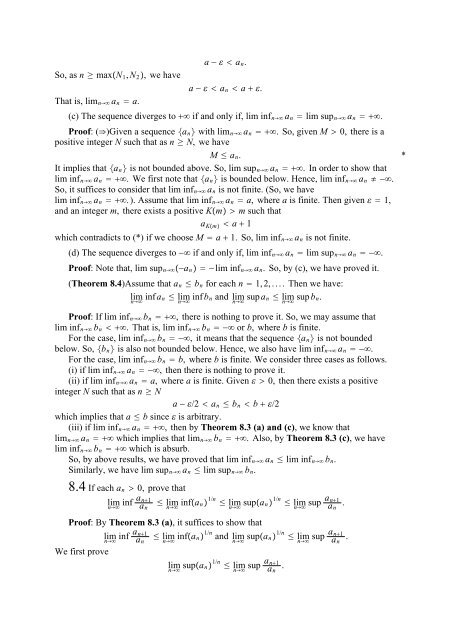The Real And Complex Number Systems
The Real And Complex Number Systems
The Real And Complex Number Systems
You also want an ePaper? Increase the reach of your titles
YUMPU automatically turns print PDFs into web optimized ePapers that Google loves.
a − a n .<br />
So, as n ≥ maxN 1 , N 2 ,wehave<br />
a − a n a .<br />
That is, lim n→ a n a.<br />
(c) <strong>The</strong> sequence diverges to if and only if, lim inf n→ a n lim sup n→ a n .<br />
Proof: ()Given a sequence a n with lim n→ a n . So, given M 0, there is a<br />
positive integer N such that as n ≥ N, wehave<br />
M ≤ a n . *<br />
It implies that a n is not bounded above. So, lim sup n→ a n . In order to show that<br />
lim inf n→ a n . We first note that a n is bounded below. Hence, lim inf n→ a n ≠−.<br />
So, it suffices to consider that lim inf n→ a n is not finite. (So, we have<br />
lim inf n→ a n . ). Assume that lim inf n→ a n a, wherea is finite. <strong>The</strong>n given 1,<br />
and an integer m, there exists a positive Km m such that<br />
a Km a 1<br />
which contradicts to (*) if we choose M a 1. So, lim inf n→ a n is not finite.<br />
(d) <strong>The</strong> sequence diverges to − if and only if, lim inf n→ a n lim sup n→ a n −.<br />
Proof: Note that, lim sup n→ −a n − lim inf n→ a n . So, by (c), we have proved it.<br />
(<strong>The</strong>orem 8.4)Assume that a n ≤ b n for each n 1,2,.... <strong>The</strong>n we have:<br />
lim n→<br />
inf a n ≤ lim n→<br />
inf b n and lim n→<br />
sup a n ≤ lim n→<br />
sup b n .<br />
Proof: If lim inf n→ b n , there is nothing to prove it. So, we may assume that<br />
lim inf n→ b n . That is, lim inf n→ b n − or b, whereb is finite.<br />
For the case, lim inf n→ b n −, it means that the sequence a n is not bounded<br />
below. So, b n is also not bounded below. Hence, we also have lim inf n→ a n −.<br />
For the case, lim inf n→ b n b, whereb is finite. We consider three cases as follows.<br />
(i) if lim inf n→ a n −, then there is nothing to prove it.<br />
(ii) if lim inf n→ a n a, wherea is finite. Given 0, then there exists a positive<br />
integer N such that as n ≥ N<br />
a − /2 a n ≤ b n b /2<br />
which implies that a ≤ b since is arbitrary.<br />
(iii) if lim inf n→ a n , then by <strong>The</strong>orem 8.3 (a) and (c), we know that<br />
lim n→ a n which implies that lim n→ b n . Also, by <strong>The</strong>orem 8.3 (c), wehave<br />
lim inf n→ b n which is absurb.<br />
So, by above results, we have proved that lim inf n→ a n ≤ lim inf n→ b n .<br />
Similarly, we have lim sup n→ a n ≤ lim sup n→ b n .<br />
8.4 If each a n 0, prove that<br />
lim n→<br />
inf a n1<br />
a n<br />
≤ lim n→<br />
infa n 1/n ≤ lim n→<br />
supa n 1/n ≤ lim n→<br />
sup a n1<br />
a n<br />
.<br />
Proof: By<strong>The</strong>orem 8.3 (a), it suffices to show that<br />
lim n→<br />
inf a n1<br />
a n<br />
We first prove<br />
≤ lim n→<br />
infa n 1/n and lim n→<br />
supa n 1/n ≤ lim n→<br />
sup a n1<br />
a n<br />
.<br />
lim n→<br />
supa n 1/n ≤ lim n→<br />
sup a n1<br />
a n<br />
.
















